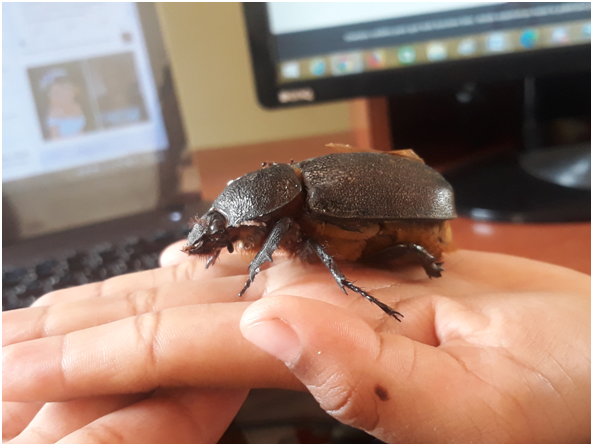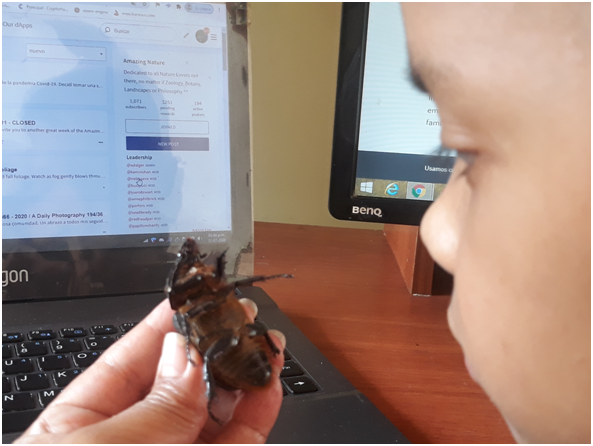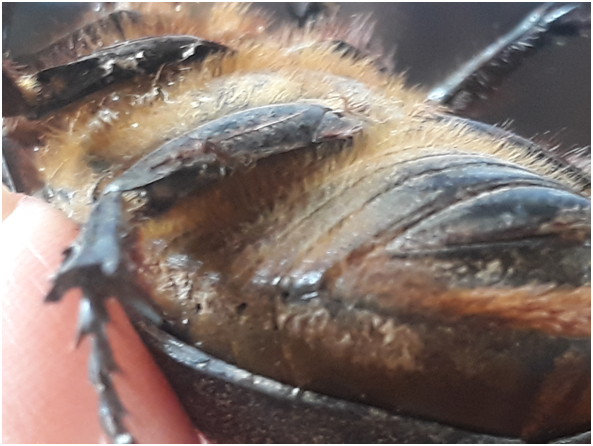
En estos días mi nieto llegó con un pequeño regalo. Dijo: "Abuela, te he traído algo muy bonito, lo estaba escondiendo, entonces él extendió su mano y en un vaso de plástico apareció una polilla con colores muy bonitos. Estaba muerta pero la tomó de todas formas y me la dio.
These days my grandson arrived with a small gift. He said: "Grandma, I brought you something very nice, I was hiding it, then he put out his hand and in a plastic cup came a moth with very nice colors. It was dead but he took it anyway and gave it to me.

Ayer volvió con otro regalo, esta vez en una bolsa de plástico. Dijo: "Te traigo otro regalo, pero esta vez para escribir un post". Este es un escarabajo rinoceronte y es enorme, no te asustes. Fue muy divertido ver su cara. No paraba de decir: "Lo arranqué de unas hormigas que se lo estaban comiendo. Pensé que estaba vivo pero no lo estaba.
Yesterday she came back with another gift, this time in a plastic bag. He said: "I bring you another gift, but this time to write a post". This is a rhinoceros beetle and it's huge, don't be scared. It was very funny to see his face. He kept saying, "**I plucked it from some ants that were eating it. I thought it was alive but it wasn't.

Es un escarabajo grande, y el que lo tiene en su mano es mi nieto. Me atrevo a decir que es uno de los más grandes que he visto. No sé si es un escarabajo ciervo u otro escarabajo pelotero. Empezamos a explorarlo, Matihas tenía curiosidad y yo aproveché la oportunidad para educarnos más.
It's a large beetle, and the one holding it in his hand is my grandson. I dare say it's one of the biggest I've ever seen. I don't know if it's a deer beetle or another dung beetle. We started to explore it, Matihas was curious and I took the opportunity to educate ourselves further.

Lo primero que vimos fueron las hormigas invasoras, había muchas devorando la parte interna del escarabajo. Tuve que deshacerme de ellas porque también estaban posando sobre mí.
The first thing we saw was the invading ants, there were many of them already devouring the inner part of the beetle. I had to shake them off because they were also posing on me.

El cuerpo de un escarabajo se clasifica en tres partes: la cabeza, el tórax y el abdomen. En la cabeza, los escarabajos tienen antenas, ojos y boca. (Los machos tienen antenas o cuernos más pronunciados). Las patas y alas del escarabajo están unidas al tórax. Como el insecto estaba muerto, no dolió desmontarlo hasta el detalle. Los escarabajos no tienen huesos internos, tienen un exoesqueleto duro en el exterior de su cuerpo. El exoesqueleto se siente duro y fuerte.

Las alas traseras de un escarabajo son marrones pero transparentes, se sienten como papel de seda. Estas alas traseras se usan para volar, no son fáciles de ver porque las alas delanteras duras las esconden. Nunca las he visto volar pero debe ser un gran peso para esas frágiles alas. Claramente, no todos los escarabajos pueden volar.
The hind wings of a beetle are brown but transparent, they feel like tissue paper. These back wings are used for flying, they are not easy to see because the hard front wings hide them. I have never seen them flying but it must be a great weight for those fragile wings. Clearly, not all beetles can fly.

Ver las rayas en el cuerpo del escarabajo con los colores amarillo y negro me recordó el cuerpo de las abejas, son idénticas al igual que las alas. Visualizamos los pelos salientes en el abdomen, así que también exploramos.
Seeing the stripes on the beetle's body with the colors yellow and black reminded me of the body of bees, they are identical just like the wings. We visualized the protruding hairs on the abdomen, so we explored that as well.

Las patas del escarabajo son fuertes, las he sentido en mis manos, Matias dijo que son pequeñas, le expliqué que las usan para cavar la tierra, caminar, correr e incluso nadar.
The beetle's legs are strong, I have felt them in my hands, Matihas said that they are small, I explained to him that they use them to dig the earth, walk, run and even swim.

Esta área es la parte de la tráquea. Tienen pelos blanco, no sé si corresponde a esa parte llamada espiráculos, los insectos la usan para tomar oxígeno y expulsar CO2. Para explicarle a Matihas utilicé Google. Preguntó por la sangre del escarabajo y a decir verdad nunca me había hecho esa pregunta antes. Resulta que los escarabajos no tienen sangre, sino un líquido que se parece a la sangre pero de color verde y que se llama hemolinfa.
This area is the part of the trachea. They have white hairs I don't know if it corresponds to that part called spiracles, insects use it to take in oxygen and expel CO2. To explain to Matihas I used Google. He asked about the beetle's blood and to tell the truth he had never asked me that question before. It turns out that beetles don't have blood but a liquid that looks like blood but is green in color and is called hemolymph.
La hemolinfa es un líquido que recorre el cuerpo de ciertos invertebrados como los artrópodos y moluscos, algo parecido a la sangre de los vertebrados. Puede ser de diferentes colores anaranjado, verdoso o incluso incolora según leí, todo dependerá de la alimentación o de los procesos metabólicos.
Hemolymph is a fluid that travels through the body of certain invertebrates such as arthropods and mollusks, somewhat similar to the blood of vertebrates. It can be of different colors orange, greenish or even colorless as I read, everything will depend on the feeding or the metabolic processes.


¡Gracias por leer, comentar y votar!


Bueno esos son los regalitos que nos traen los nietos
Así es!! Ambos aprendemos ;)